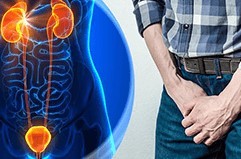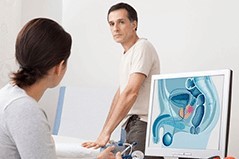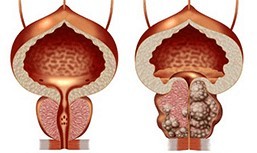Prostatitis - inflammation of the prostate (prostate cancer), the organ that produces a liquid secret, incoming in the composition of the semen. Pathology sometimes causes severe pain and problems with potency. Treatment of prostatitis wise to start immediately after his diagnosis.
Symptoms
Prostatitis usually affects men from 25 to 50. Pathology is very common. From her suffering from a third to a half of all the men on the planet. The problems many of the symptoms:

- a person experiences discomfort, pain when urinating;
- urine is slow, thin trickle, her pose pushed out;
- at night and at a different time of day, often there is a desire to fix a small need. Not leave feeling that not all urine has left the bladder;
- urine is turbid with admixture of blood;
- bug pain in the lower part of the abdomen, pain, inguinal region, in the area of the perineum (between the scrotum and the anus);
- also haunted by pain, discomfort in the testicles, of the penis;
- ejaculation happens with pain;
Often occur symptoms of prostatitis, which are similar to the common cold (lower temperature, the heat). Are characteristic of the bacterial species pathology (about it below).
Reasons
Prostatitis occurs more often in men, previously, have had this disease. Problem it creates:
- infection in the urinary bladder and urethra;
- HIV and other diseases, by which a person becomes infected during sex;
- trauma in the pelvic area - a fall from a bicycle, a horse;
The cause of prostatitis in men the catheter in the urethra for the exit of urine from the bladder.
Pathology sometimes appear after a prostate biopsy, when the analysis is taken a sample of his tissue. After this procedure the symptoms of prostatitis in men are observed only rarely.
Complications
Because of prostatitis can:
- inflamed pendant of the testicles (epididymitis);
- significantly reduce the content of sperm, arise infertility;
- discover the abscess (cavity with pus).

Numerous studies of scientists not finding a direct link between prostatitis and prostate cancer.
Types of prostatitis
In prostatitis 5 basic types: chronic and acute non-bacterial, chronic, and acute bacterial, asymptomatic.
- Chronic non-bacterial (it's the same syndrome of chronic pain in the pelvic area). The most common (more than 90% of all patients fall ill to them). Symptoms of prostatitis impermanent, come and go. Pathogens in the body was not found. The diagnosis is, if after a period of at least 3-x months, a man suffering from pain in the pelvic area, discomfort during urination and other symptoms listed above. The exact cause of the development of the disease is unknown, but it's probably cause:
- neurological problems (neuropathy);
- irritation of the prostate gland, which creates a bad drain urine from the bladder;
- problems with the muscles of the pelvic floor (dyssynergia);
- atypical, yet unknown to science, viruses, bacteria.
- Acute non-bacterial. It is accompanied by chronic pain syndrome in the pelvic area, constant problems with urination.
- Acute infectious. The most severe form of the disease. Occurs rarely. Created:
- the intestinal stick, staphylococcus and other bacteria;
- sexually transmitted pathologies (chlamydia, gonorrhea);
- the fungus Candida.
- Chronic infectious. Pathology can to get to know a few years. Symptoms similar to the acute bacterial type, but manifest themselves so strongly.
- Asymptomatic. Detected randomly. Has no symptoms. ULTRASOUND shows signs of inflammation and blood count - increased content of prostatospecific antigen.

The symptoms grow quickly. Discomfort in the pelvis connects the soreness of the genitals, fever, nausea, burning pain when urinating. The acute form of bacterial prostatitis can cause serious, life-threatening complications - abscesses, inability to urinate, low blood pressure.
Diagnose
The diagnosis is made by:
- thumb rectal studies;
- analysis of the urine. It is necessary to determine whether it is in the prostate gland infection;
- the analysis of blood. Controlling the level of prostatospecific antigen. Test reveals signs of inflammation;
- ULTRASOUND examination of the organs of the urinary system. In the case where these tests for the determination of an accurate diagnosis is not enough. ULTRASOUND of the prostate is more appropriate to do through the anus (transrectally way).
Also sometimes the doctor examines the secret of the prostate gland. To get it, carried the massage of the breast.
Can set apart the tests on different venerologic infections, which are the cause of the inflammation of the prostate gland.
Professional to diagnose you to prescribe the right treatment prostatitis in men.
Treatment
If the prostatitis is bacterial, the doctor will prescribe:
- Antibiotics. Their appearance depends on the identified bacteria. Take medication need to a month and a half. If symptoms are very severe, antibiotics urgently injected intravenously.
- The alpha-blockers. Means relax the muscles of the bladder in the place where he connects with the prostate gland. Eliminate the pain when urinating.
- Analgesics - non-steroidal anti-inflammatory agents.

Cannot determine the the drugs themselves. Only the doctor will determine how to treat prostatitis.
Prevention
To prevent prostatitis:
- we accept warm sitz baths;
- apply to lower abdomen or back pain heating pad-the pillow;
- loss consume alcohol, caffeine, food, which increases the acidity (spicy, salty);
- her a lot of fluids (salty). So we rinsed the genitourinary system, the bacteria do not have time to to breed;
- try time to ride a bike, sit for long periods;
- do not forget about the hygiene of the penis, perineal;
- we use the contraceptives;
- we deal with sport. Simple cardio exercises will be quite enough - start to run around, swim in the pool, do a light workout.
Prevention of prostatitis should become part of the lifestyle. Simple ways to protect the body.































